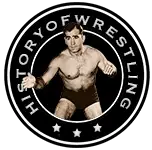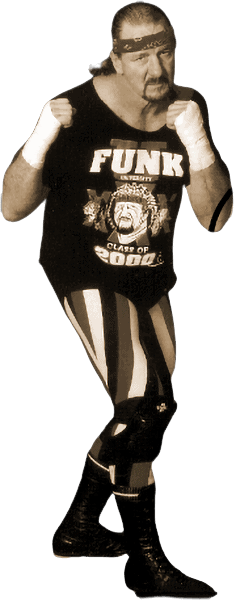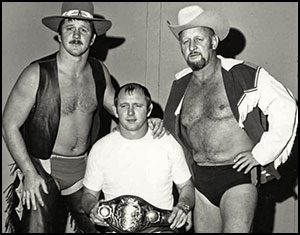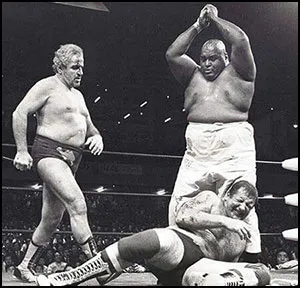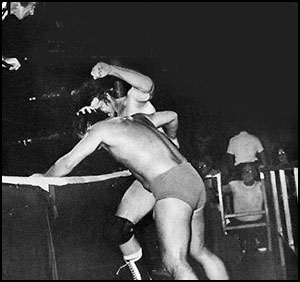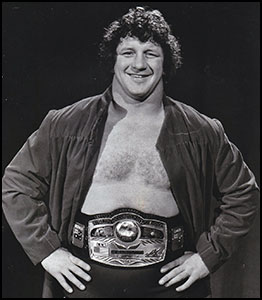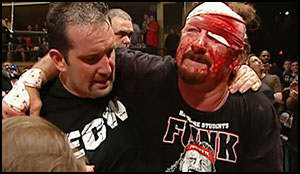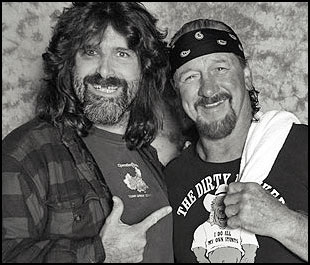by Stephen Von Slagle
Over the course of professional wrestling’s long history, few men have commanded the kind of instant respect from both the fans and his co-workers as the wildman from the Double-Cross Ranch in Amarillo, Texas, former NWA and ECW World Heavyweight champion Terry Funk. For more than fifty years, the rugged Texan brought both excitement and respect to his chosen profession and influenced countless future wrestlers along the way. A man who was as kind and gentle away from the ring as he was unpredictable and brutal inside of it, Funk was also one of the great teachers in wrestling history. Having trained the likes of Bob Backlund, Stan Hansen, Bruiser Brody, Tito Santana, Ted Dibiase and countless other wrestling legends for their careers in the sport, Terry (along with his older brother and father) undoubtedly helped shape wrestling for decades to come, both in North America and Japan. A former NWA World Heavyweight champion during the mid-Seventies, Terry Funk remained a highly relevant figure in the business for decades after his World title reign ended and he was a constant source of controversy and excitement even into the new millennium. A man who, due to his vast knowledge of the business and an innate ability to read the future trends of pro wrestling long before they actually happened, The Funker was always able to stay a step ahead of everyone else and lead the pack, even in cases where he was decades older than his opponent and/or co-workers. Truly, there have been few individuals as important to the industry as the one and only “Hardcore Legend” Terry Funk.
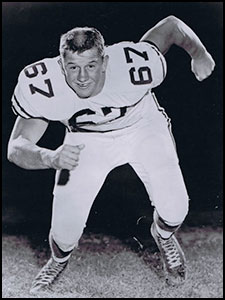 Terry Funk was born on June 30, 1944, in Hammond, Indiana and grew up in the Lone Star State of Texas. Following in the footsteps of his famous father and brother, Funk began his career in pro wrestling after graduating from West Texas State University, where he had excelled at football. The future World champion made his debut in 1965, wrestling for his father’s successful Amarillo promotion. Not surprisingly, given his upbringing, the agile & talented second-generation performer quickly became a top star in the territory. With his youthful good looks, a famous wrestling name and an obvious abundance of talent, the youngest Funk instantly became a popular fan favorite in Amarillo upon his debut and it was not long after breaking into the sport that Funk, along with Ricky Romero, picked up one of his first championships in the form of the NWA Western States Tag Team title. With Romero as his partner, Funk twice won the Western States Tag title, first in 1969 and then again in 1970. In terms of his early singles championships, the youngest Funk won the Texas Brass Knuckles championship in 1972 as well as the NWA Western States title five times between 1970 through 1974.
Terry Funk was born on June 30, 1944, in Hammond, Indiana and grew up in the Lone Star State of Texas. Following in the footsteps of his famous father and brother, Funk began his career in pro wrestling after graduating from West Texas State University, where he had excelled at football. The future World champion made his debut in 1965, wrestling for his father’s successful Amarillo promotion. Not surprisingly, given his upbringing, the agile & talented second-generation performer quickly became a top star in the territory. With his youthful good looks, a famous wrestling name and an obvious abundance of talent, the youngest Funk instantly became a popular fan favorite in Amarillo upon his debut and it was not long after breaking into the sport that Funk, along with Ricky Romero, picked up one of his first championships in the form of the NWA Western States Tag Team title. With Romero as his partner, Funk twice won the Western States Tag title, first in 1969 and then again in 1970. In terms of his early singles championships, the youngest Funk won the Texas Brass Knuckles championship in 1972 as well as the NWA Western States title five times between 1970 through 1974.
But, with his older brother Dory in the middle of enjoying what would become a four-year reign as the NWA World Heavyweight champion, Terry eventually began traveling outside of the Amarillo territory. Although he portrayed the role of a babyface for most of his title reign, as the traveling champion, Dory Funk, Jr. would often have to wrestle babyface contenders while assuming a more heelish role. Oftentimes, Terry (who, once he “turned,” was a natural heel and someone able to evoke a great deal of negativity from his audience) would arrive in a territory a few weeks ahead of his brother and engage in a feud with the top local babyface. After a few heated matches, the fan favorite oftentimes “earned” a shot at the World champion by defeating his younger brother. As a result of all the controversy, wrestling fans of the day would line up to see the big payoff match, with the title on the line. Indeed, it was a very successful formula that was of significant benefit to the still young Terry, who gained a great deal of experience while acting as his brother’s “enforcer.”
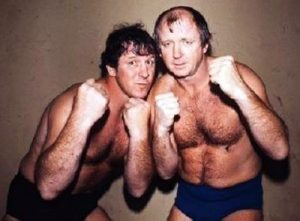 Beginning in the late Sixties (and lasting into the Eighties) the tag team of Dory & Terry Funk was one of the most talented, respected, and oftentimes, hated duos in all of pro wrestling. Their legendary family feud with the Brisco Brothers, Jack & Jerry, was among the most heated and longest running programs in wrestling history.
Beginning in the late Sixties (and lasting into the Eighties) the tag team of Dory & Terry Funk was one of the most talented, respected, and oftentimes, hated duos in all of pro wrestling. Their legendary family feud with the Brisco Brothers, Jack & Jerry, was among the most heated and longest running programs in wrestling history.
The two incredibly talented teams, with one set of brothers hailing from Texas and the other from neighboring Oklahoma, were the living definition of the term “natural rivals” and the hundreds of matches the two wrestled against each other were always characterized by superior mat action and remarkably intense competition. In addition to their legendary feud against the Briscos, the Funk Brothers engaged in several other lengthy, bloody feuds, in both North America and Japan, most notably against Dusty Rhodes & Dick Murdoch, The Invaders and The Sheik & Abdullah the Butcher. Whether they were wrestling in the U.S., Japan, Mexico, Puerto Rico or Canada, the team of The Funks were always at the center of controversy within the tag team ranks and invariably deeply involved in the title picture.
Together, they captured the World Wrestling Council Tag Team championship twice, and held the prestigious Puerto Rican belts for more than two years all total. The Funks also won the World Tag Team title (Amarillo version) twice in 1968, the NWA International Tag Team titles three times between 1971-1973, the Florida Tag Team title in 1971 and Georgia Tag Team championship in 1978.
Dory and Terry also teamed to win the NWA World Tag Team championship (Los Angeles version) and the Southwest Championship Wrestling World Tag team title, both in 1980, as well as the NWA North American Tag Team championship in 1981. Of course, Terry Funk did anything but live in his older brother’s shadow and the youngest member of the famous wrestling family picked up more than his fair share of prestigious singles championships during his early years in the business. During a successful run in Florida (the first of many for Funk) in 1971, he won both the Southern Heavyweight & Florida TV titles. Elsewhere within the NWA territorial structure, Funk captured the Americas Heavyweight (Los Angeles) and the Missouri Heavyweight titles, both in 1973. Another major championship held by Terry Funk (twice, first in 1975 and then again in 1976) was the International Heavyweight title, which eventually became part of All-Japan’s prestigious Triple Crown championship.
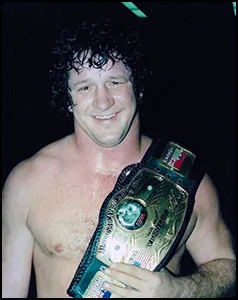 The reason for Funk’s early success was due greatly to his solid grasp of wrestling fundamentals combined with his determination to continue learning and developing as a technical wrestler. While he is deservedly known as one of the greatest brawlers in pro wrestling history, the early portion of Funk’s career also contained a great deal of traditional scientific wrestling. A master of the Spinning Toe Hold, Funk also developed his offensive repertoire to the point where he featured textbook examples of any number of finishing maneuvers, including the Figure Four Leglock, an array of Suplexes and a truly devastating Piledriver. Still, even back during his earliest years in the sport, Funk’s propensity for wild, unpredictable & very realistic brawling was quite evident. However, despite his reputation as being a bit of a maverick, his talent and marketability was too great to ignore and the decision was made by the NWA championship committee to put the World Heavyweight title around the waist of Terry Funk. On December 10, 1975, Funk defeated reigning NWA champion Jack Brisco in Miami, Florida to win the richest prize in pro wrestling. Terry’s World title victory (which came just two and a half years after Dory lost the title) made history in more ways than one, with the Funks being the only brothers to have both worn the NWA World championship belt, establishing the Funk family as a wrestling dynasty unlike any other.
The reason for Funk’s early success was due greatly to his solid grasp of wrestling fundamentals combined with his determination to continue learning and developing as a technical wrestler. While he is deservedly known as one of the greatest brawlers in pro wrestling history, the early portion of Funk’s career also contained a great deal of traditional scientific wrestling. A master of the Spinning Toe Hold, Funk also developed his offensive repertoire to the point where he featured textbook examples of any number of finishing maneuvers, including the Figure Four Leglock, an array of Suplexes and a truly devastating Piledriver. Still, even back during his earliest years in the sport, Funk’s propensity for wild, unpredictable & very realistic brawling was quite evident. However, despite his reputation as being a bit of a maverick, his talent and marketability was too great to ignore and the decision was made by the NWA championship committee to put the World Heavyweight title around the waist of Terry Funk. On December 10, 1975, Funk defeated reigning NWA champion Jack Brisco in Miami, Florida to win the richest prize in pro wrestling. Terry’s World title victory (which came just two and a half years after Dory lost the title) made history in more ways than one, with the Funks being the only brothers to have both worn the NWA World championship belt, establishing the Funk family as a wrestling dynasty unlike any other.
Although he defended his championship against a plethora of top opponents (including major feuds with the likes of Dusty Rhodes, Dick the Bruiser, Harley Race, Jerry Lawler, Giant Baba and many others) in territories across the world, it is probably safe to say that Terry Funk’s primary opponent while champion was also his brother’s archrival, the man Terry won the title from, the ultra-talented amatuer-turned-pro, Jack Brisco. A rivalry as intense as any in the annals of wrestling history, it was not at all uncommon for their heated, emotional battles to run the full sixty minutes allotted for a championship encounter. It was, in fact, uncommon if they didn’t.
For a year and a half, Terry Funk stood atop the wrestling world as the NWA titleholder and in the tradition of previous NWA champions, he defended his gold belt relentlessly in each of the numerous territories in every nation represented by the National Wrestling Alliance offices. But, what goes up must also come down, and every champion’s reign eventually reaches its end, even one as exciting as Terry Funk’s. On February 6, 1977, Harley Race (the same man who, four years earlier, had ended Dory’s reign as champion) defeated Terry Funk for the NWA championship in front of an overflowing crowd at Toronto’s Maple Leaf Gardens. Despite his loss of the World championship, Funk remained a top competitor both at home & overseas (particularly in Japan, were both he and his brother are revered legends) and he was in constant demand by promoters worldwide. Still, as the decade of the Seventies began to end, Terry Funk suddenly started wrestling less and less frequently. Not surprisingly, there was much speculation regarding the former champ’s future in wrestling, or lack thereof. However, his fans would later find out that his conspicuous absence was due to the fact that Funk was beginning to lay the groundwork for a new career as an actor in Hollywood.
In 1978, Terry Funk made his big-screen debut as Frankie the Thumper in Sylvester Stallone’s Paradise Alley. Portraying the role of, you guessed it, a professional wrestler, Funk received unanimously positive reviews of his strong performance in the film. With that in mind, it’s no surprise that in the years following his motion picture debut, the wrestler-turned-actor amassed a very impressive list of credits, both as an actor and a stuntman.
In addition to his featured character in Paradise Alley, Funk starred in another big role opposite Stallone in Over the Top (1987), played an important character in Patrick Swayze’s Road House (1989), as well as Mom Can I Keep Her? (1998) and, of course, Barry Blaustein’s Beyond the Mat (2000). Funk also landed major parts in several television series, including Quantum Leap, Swamp Thing, Tequila & Bonetti, The Adventures of Brisco County, Jr., and Thunder In Paradise.
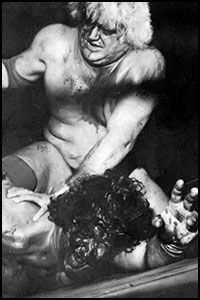
Yet, despite his success in Hollywood, Funk was eventually drawn back to his first love, the wrestling ring. Although he had wrestled dozens of matches since the release of Paradise Alley, Funk’s true return to the wrestling spotlight came on August 21, 1979.That night, prior to an NWA title defense by the newly-crowned champion Dusty Rhodes, Funk stormed the ring and attacked Rhodes, breaking the new champ’s arm. Rhodes refused to pull out of his title defense, though, and as a direct result of the “injury” caused by Funk, “The American Dream” lost his title that night to the former champion, Harley Race, less than seven days after winning it. The sneak attack sent waves of outrage throughout the NWA fanbase and Funk instantly resumed his position as the most hated man in the sport. To add insult to injury, immediately following his attack on Rhodes, The Funker won a tournament to determine the new Florida Heavyweight champion, a title that had been vacated a week earlier by “The American Dream” when Rhodes won the NWA World title. The angle (and, in particular, Funk’s crazed attack on the new champion) has gone down as one of the most effective in wrestling history, yet, in hindsight, it was only the latest chapter in the storied Funk-Rhodes war.
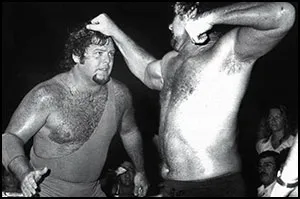 Another legendary feud that Funk participated in was his program against Jerry “The King” Lawler. During the early Eighties, Funk and Lawler tore into each other during a truly barbaric, bloody series of matches that originally began in the Memphis territory, eventually moved to the Florida territory, and then returned back to Memphis. Perhaps the most famous of the many encounters during their long running feud was the one that, ironically enough, nobody saw. Inside of an eerily empty Mid South Coliseum, without a single fan inside of the cavernous 11,500-seat building, Funk and Lawler battled each other in one of the strangest and most creative matches of its time. Once again, Terry Funk was riding on the cutting edge of his profession. It wasn’t the first time, and it certainly wouldn’t be the last.
Another legendary feud that Funk participated in was his program against Jerry “The King” Lawler. During the early Eighties, Funk and Lawler tore into each other during a truly barbaric, bloody series of matches that originally began in the Memphis territory, eventually moved to the Florida territory, and then returned back to Memphis. Perhaps the most famous of the many encounters during their long running feud was the one that, ironically enough, nobody saw. Inside of an eerily empty Mid South Coliseum, without a single fan inside of the cavernous 11,500-seat building, Funk and Lawler battled each other in one of the strangest and most creative matches of its time. Once again, Terry Funk was riding on the cutting edge of his profession. It wasn’t the first time, and it certainly wouldn’t be the last.
 As the decade’s first few years passed, it became clear that the wrestling business was about to undergo a major upheaval that would reverberate across the entire wrestling world, courtesy of the World Wrestling Federation’s ambitious new owner/operator, Vincent K. McMahon. Once McMahon had launched his historic national expansion and the country was gripped by Hulk-a-Mania, Terry Funk was brought into the WWF, specifically to feud with the incredibly popular new champion. Hogan and Funk battled in sold-out WWF arenas throughout the U.S. and Canada and their big showdown on NBC’s Saturday Night’s Main Event posted some of the biggest numbers in the highly-rated series’ history. After his feud against Hogan had run its course, Terry was joined in the WWF by his older brother Dory and, later, their “half-brother” Jimmy Jack Funk (Jesse Barr). The Funk family quickly became a major factor within the WWF’s crowded tag team ranks and, it was during this stay in the WWF that Terry first started bringing his infamous (and, at times, flaming) branding iron to the ring.
As the decade’s first few years passed, it became clear that the wrestling business was about to undergo a major upheaval that would reverberate across the entire wrestling world, courtesy of the World Wrestling Federation’s ambitious new owner/operator, Vincent K. McMahon. Once McMahon had launched his historic national expansion and the country was gripped by Hulk-a-Mania, Terry Funk was brought into the WWF, specifically to feud with the incredibly popular new champion. Hogan and Funk battled in sold-out WWF arenas throughout the U.S. and Canada and their big showdown on NBC’s Saturday Night’s Main Event posted some of the biggest numbers in the highly-rated series’ history. After his feud against Hogan had run its course, Terry was joined in the WWF by his older brother Dory and, later, their “half-brother” Jimmy Jack Funk (Jesse Barr). The Funk family quickly became a major factor within the WWF’s crowded tag team ranks and, it was during this stay in the WWF that Terry first started bringing his infamous (and, at times, flaming) branding iron to the ring.
But, as he began to land more and more parts as a film actor, Funk again began wrestling less frequently and eventually faded from the wrestling scene once again. Indeed, during much of the latter portion of the Eighties, Funk did not wrestle at all. Although he had not made an official announcement, most fans simply assumed that the fortysomething Funk had simply retired again, permanently, this time. But, in 1989, he returned to the wrestling scene via TBS and the NWA, as Funk was brought in to do the color commentary for the NWA’s Music City Showdown pay-per-view, which featured the latest in a long line of classic Ric Flair vs. Rick Steamboat encounters. Following a truly incredible marathon of a match, Flair was able to score a pinfall on the champion Steamboat and “The Nature Boy” regained his coveted World championship. After the match, Funk left his seat at the announcing table and entered the ring to congratulate Flair on his hard-earned victory. The former champion then let it be known that he would also like to be the first to challenge the new champion. But Flair, after noting Funk’s retirement from wrestling and his successful movie career, suggested that Terry could not simply walk back into wrestling and immediately get a shot at the World title. Flair then assured Funk that once he was the NWA’s number one contender, he would be happy to wrestle him. Until then, though, Flair felt that the men already in the Top Ten deserved the first shots at his title.
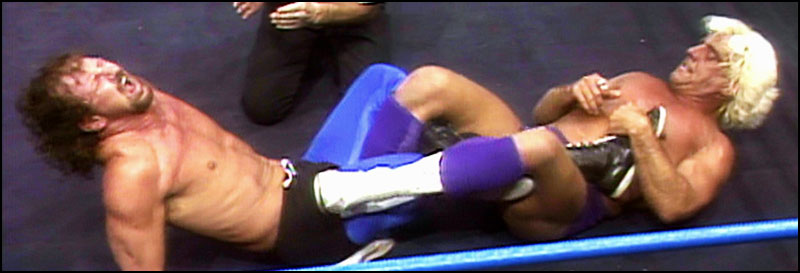
Instantaneously, Funks demeanor went from friendly & congratulatory to angry & confrontational, and he accused Flair of saying that he “wasn’t good enough” to wrestle for the World championship. A calm yet exhausted Flair assured Funk that he wasn’t saying that at all, but rather, simply that Funk would have to earn his shot at the title. Terry’s erratic behavior then settled down as he seemed to understand and accept Flair’s explanation, and he eventually apologized to Flair for the misunderstanding. The former champion extended his hand in friendship to the new titleholder, and when the forgiving Flair went to shake it, Funk blasted him in the face with a wicked left hand that dropped “The Nature Boy” like a rock. With Flair prone on the mat and the fans in attendance in a frenzy, Funk, decked out in a black tuxedo, attacked Flair with a vengeance. After pummeling & bloodying the unsuspecting champion in the ring, Funk took the action to the floor and, in one of the most memorable moments in NWA/WCW history, the wild-eyed, crazed Texan executed his famous Piledriver on the bleeding Flair on top of the announcer’s table.
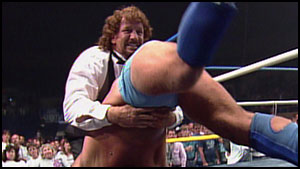 While this highly visual spot would eventually become commonplace during the late Nineties, in 1989, the act of putting a man through a table via a Piledriver was virtually unheard of. Due to this unthinkably vicious and heinous act, Slick Ric’s neck was “broken” and Flair (who had been the most hated man in the NWA going into the match, but by the end of it had, through no coincidence, emerged as the top babyface) remained out of action for more than three months while “recovering.” Meanwhile, as he waited for Flair to return, Funk faced off against the NWA’s bounty of top superstars, including the likes of Steamboat, Sting and Lex Luger. It soon became clear to viewers that Funk’s contract had been taken over by the nefarious NWA manager Gary Hart, who also handled the careers of the ultra-impressive Great Muta and grizzled veteran Dick Slater, among others.
While this highly visual spot would eventually become commonplace during the late Nineties, in 1989, the act of putting a man through a table via a Piledriver was virtually unheard of. Due to this unthinkably vicious and heinous act, Slick Ric’s neck was “broken” and Flair (who had been the most hated man in the NWA going into the match, but by the end of it had, through no coincidence, emerged as the top babyface) remained out of action for more than three months while “recovering.” Meanwhile, as he waited for Flair to return, Funk faced off against the NWA’s bounty of top superstars, including the likes of Steamboat, Sting and Lex Luger. It soon became clear to viewers that Funk’s contract had been taken over by the nefarious NWA manager Gary Hart, who also handled the careers of the ultra-impressive Great Muta and grizzled veteran Dick Slater, among others.
Of course, the excitement caused when Flair finally returned to action against Funk translated into the biggest P.P.V. numbers the promotion had ever garnered up to that point, as well as stellar ratings for the episodes of TBS’s Clash of the Champions that featured the ongoing Flair-Funk war. Following his lengthy, intense feud with Flair, Funk continued to compete and he remained a key player within the NWA However, then-NWA/WCW President Jim Herd was intent on “retiring” Funk and, consequently, his talents were put to work behind the scenes as part of the NWA’s creative team. As a result, Funk began to slowly reduce his air time to the point where he was able to make the transition from a hated wrestler to a respected TV announcer. As a color man (Funk worked primarily opposite lead announcer Jim Ross, as well as Gordon Solie and play-by-play man Chris Cruise) The Funker became an integral part of the NWA broadcast team, working not only on WCW Saturday Night but also as the color commentator for the NWA/WCW’s syndicated programs and the monthly pay-per-view shows. For the better part of two years, Funk was one of the NWA/WCW’s main voices and he capably filled the role of a knowledgeable veteran commentator. But, as always, there was another new challenge awaiting Terry Funk and he listened to his gut instinct, travelling wherever it told him to go.
Following his run in WCW, the “retired” Funk once again made a surprise return to in-ring action. First, he made an unexpected stop in Memphis, home of the USWA, and renewed his unending feud with Jerry “The King” Lawler. Picking up right where they’d left off years earlier, the two legends battled for pride and championship gold, with Funk adding insult to injury by taking Lawler’s USWA Unified World Heavyweight title on November 5, 1990. Funk then went on to rule The King’s kingdom for nearly six months before dropping the title back to Lawler on March 11, 1991. After his stay in the USWA came to an end, Funk moved on to new challenges and, in genuine Terry Funk fashion, he did so with the one promotion that was truly on the cutting edge of the wrestling scene, the violent, controversial group known as ECW. While he was decades older than his young ECW competition, Funk nevertheless more than held his own during this, the fourth separate decade in which he had wrestled. Trading in his old Spinning Toe Hold for top-rope Moonsaults and Hurricanranas, the adaptable veteran was by no means a throwback to some long-lost era. Instead, Funk, as always, established himself as a leader, not a follower. Early in 1993, he defeated Jimmy Snuka to win the ECW World TV title (which he eventually lost to one of his major ECW foes, the suicidal Sabu) and then followed that up by winning the Eastern Championship Wrestling Heavyweight title on December 26, 1993. Having a legendary, world-famous former NWA World champion as its titleholder definitely added credibility to the young independent promotion. However, having a champion (and locker room leader) as dedicated and hardworking as Terry Funk proved to be even more valuable to ECW.
His first reign as the ECW champion ended when he lost to “The Franchise” Shane Douglas during a special 8-man tag match that pitted Douglas & Mr. Hughes & The Public Enemy vs Funk & Road Warrior Hawk & Kevin Sullivan & The Tazmaniac. Following his loss of the title, Funk engaged in a exciting new feud with ECW’s foul-mouthed but highly talented Franchise and, at the same time, continued his endless war against Sabu. Much as he had done with the upstart Japanese hardcore leagues FMW and the IWA, Terry Funk worked hard at establishing ECW as a legitimate, successful wrestling promotion by giving 100% of his efforts in each and every match he wrestled. Equally important was the fact that he helped nurture and guide the young ECW locker room during its infancy, conveying his wealth of knowledge to the next generation of workers.
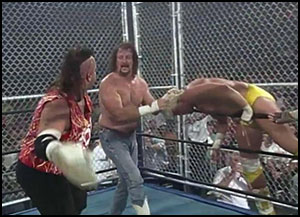 Midway through the decade, though, Funk left ECW briefly to return to WCW, where he once again wasted no time in stirring up trouble. This time, Funk was back to reignite his feud with arch nemesis “The American Dream” Dusty Rhodes, via Rhodes’ young son, Dustin. While the Terry Funk vs. Dustin Rhodes matches did not necessarily carry the same weight and importance that his battles with Dusty had twenty years earlier, their mid-Nineties feud in WCW was still very hard-fought, exciting and, at times, quite bloody. Under the managerial guidance of Col. Robert Parker, Funk also formed a fairly successful team with Bunkhouse Buck during this tour of World Championship Wrestling. Still, the wily former champion was never one to wear out his welcome, and once he felt it was time to move on, Funk didn’t hesitate. Meanwhile, ECW owner Paul Heyman was more than happy to welcome his former World champion back to the renegade northeastern promotion. By the time he once again began wrestling for ECW full-time, pro wrestling’s “little promotion that could” had outgrown its once very regional boundaries and was ready to go national. Not long after his return, “The Hardcore Legend” regained the ECW (which was no longer known as Eastern, but rather, Extreme Championship Wrestling) World title on April 13, 1997 in the main event of the upstart company’s first pay-per-view, Barely Legal. The Funker held the ECW World title for nearly a half-year and, as the promotion’s base of operations grew, he defended the prestigious young belt in new ECW cities across the country.
Midway through the decade, though, Funk left ECW briefly to return to WCW, where he once again wasted no time in stirring up trouble. This time, Funk was back to reignite his feud with arch nemesis “The American Dream” Dusty Rhodes, via Rhodes’ young son, Dustin. While the Terry Funk vs. Dustin Rhodes matches did not necessarily carry the same weight and importance that his battles with Dusty had twenty years earlier, their mid-Nineties feud in WCW was still very hard-fought, exciting and, at times, quite bloody. Under the managerial guidance of Col. Robert Parker, Funk also formed a fairly successful team with Bunkhouse Buck during this tour of World Championship Wrestling. Still, the wily former champion was never one to wear out his welcome, and once he felt it was time to move on, Funk didn’t hesitate. Meanwhile, ECW owner Paul Heyman was more than happy to welcome his former World champion back to the renegade northeastern promotion. By the time he once again began wrestling for ECW full-time, pro wrestling’s “little promotion that could” had outgrown its once very regional boundaries and was ready to go national. Not long after his return, “The Hardcore Legend” regained the ECW (which was no longer known as Eastern, but rather, Extreme Championship Wrestling) World title on April 13, 1997 in the main event of the upstart company’s first pay-per-view, Barely Legal. The Funker held the ECW World title for nearly a half-year and, as the promotion’s base of operations grew, he defended the prestigious young belt in new ECW cities across the country.
Funk’s final reign as the kingpin of Extreme Championship Wrestling ended on August 9, 1997 when he dropped the title to archrival Sabu in Philadelphia, Pennsylvania. Having elevated several of the young ECW stars while champion, Funk remained a key member of the ECW roster, despite no longer holding the promotion’s World Title belt. He soon became involved in a controversial and violent feud with a wrestler who was actually very similar to him, the maniacal Cactus Jack, which further strengthened the overall ECW lineup with a very strong, headlining bout that did not involve any title belts. What was involved in the Cactus-Funk feud, however, was plenty of blood, fire, more blood, non-stop 4-star brawling, a variety of weapons & props, a bit more blood, a chaotic near riot, and, yes, more blood. And, it was within those bloodstained rings of Extreme Championship Wrestling that Terry Funk was truly in his own element. As always, though, new challenges beckoned Funk and eventually, his time in ECW came to its end. Following his five-year run with the trendsetting young promotion, he returned to the WWF after a ten-year absence from the Federation. Portraying a character named “Chainsaw Charlie,” Funk became involved in a long running storyline with his former ECW & Japanese rival Cactus Jack, better known in the WWF as Mankind. The two brawlers fought both with and against each other during their WWF program, and together they scored a WWF World Tag team title along the way by defeating the New Age Outlaws in 1998. To his enduring credit, the aged & battered ring warrior never failed to keep up with the talented & hungry WWF workers of the day, most of whom were thirty (or more) years younger than the rugged veteran.
Following a brief period away from the action once his storyline with Mick Foley had run its course, Funk (once again) made an unexpected return to pro wrestling in 2000. However, this time it was not with ECW or the WWF, but instead as the new Commissioner of the Federation’s primary competitor, Ted Turner’s WCW. As the new WCW Commissioner, The Funker took on the imposing forces of the newly reunited NWO. Although the role of commissioner had actually been planned for Ric Flair, a contract dispute kept “The Nature Boy” from appearing and, in his place, WCW chose “The Hardcore Legend” Terry Funk, who did his best with the new and challenging assignment. Commissioner Funk was part of several highly entertaining storylines, including the formation of his anti-NWO group, The Old Age Outlaws, and the infamous “chicken-on-a-fist” angle, among others. Clearly, Funk had not lost his touch, nor his sense of humor. Eventually, though, he lost a match to Kevin Nash that stripped him of his duties as WCW Commissioner. Yet, true to form, Funk (who by this time was nearly sixty years old) simply bounced back by winning the WCW Hardcore title no less than three times in 2000. He gained his first WCW Hardcore title by defeating the entertaining “Screamin” Norman Smiley, his second by going over a former ECW rival in “The Franchise” Shane Douglas and his final Hardcore title victory came when defeated the young and talented Crowbar.
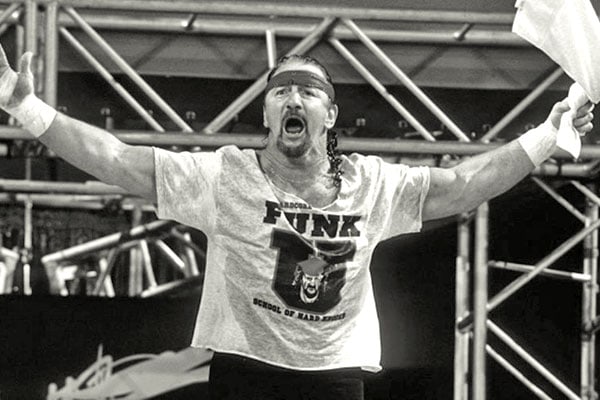 Unfortunately, yet somewhat appropriately, Funk was also in WCW at the time when the once mighty promotion, the last surviving remnant of the original National Wrestling Alliance, ceased to exist in 2001. With the end of WCW came, seemingly, the end of Terry Funk’s incredible career in pro wrestling. True to form, though, he soon resurfaced and was involved in major storylines for both Ring of Honor and, later, Major League Wrestling. He also returned to the Land of the Rising Sun, wrestling matches in both New Japan and All Japan, all while being just a few years short of 70 years old. On September 22, 2017, a 72 year-old Funk wrestled what was purported to be his final match, teaming with the Rock & Roll Express to defeat Jerry Lawler, Brian Christopher and Doug Gilbert. However, if history is any indicator, Terry Funk hasn’t actually retired, he’s just waiting for the right time to make his next surprise sneak attack…
Unfortunately, yet somewhat appropriately, Funk was also in WCW at the time when the once mighty promotion, the last surviving remnant of the original National Wrestling Alliance, ceased to exist in 2001. With the end of WCW came, seemingly, the end of Terry Funk’s incredible career in pro wrestling. True to form, though, he soon resurfaced and was involved in major storylines for both Ring of Honor and, later, Major League Wrestling. He also returned to the Land of the Rising Sun, wrestling matches in both New Japan and All Japan, all while being just a few years short of 70 years old. On September 22, 2017, a 72 year-old Funk wrestled what was purported to be his final match, teaming with the Rock & Roll Express to defeat Jerry Lawler, Brian Christopher and Doug Gilbert. However, if history is any indicator, Terry Funk hasn’t actually retired, he’s just waiting for the right time to make his next surprise sneak attack…
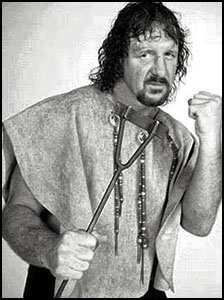 Terry Funk is the recipient of several prestigious awards, including Pro Wrestling Illustrated’s Wrestler of the Year (1976), Tokyo Sports’ Lifetime Achievement Award (1983), and the Cauliflower Alley Club’s Iron Mike Mazurki Award (2005). Funk is also a member of the WCW Hall of Fame (1995), the Stampede Wrestling Hall of Fame (1995), the Wrestling Observer Newsletter Hall of Fame (1996), the Professional Wrestling Hall of Fame and Museum (2004), the WWE Hall of Fame (2009), the NWA Hall of Fame (2009), the St. Louis Wrestling Hall of Fame (2010), and the International Wrestling Institute & Museum’s George Tragos/Lou Thesz Professional Wrestling Hall of Fame (2010).
Terry Funk is the recipient of several prestigious awards, including Pro Wrestling Illustrated’s Wrestler of the Year (1976), Tokyo Sports’ Lifetime Achievement Award (1983), and the Cauliflower Alley Club’s Iron Mike Mazurki Award (2005). Funk is also a member of the WCW Hall of Fame (1995), the Stampede Wrestling Hall of Fame (1995), the Wrestling Observer Newsletter Hall of Fame (1996), the Professional Wrestling Hall of Fame and Museum (2004), the WWE Hall of Fame (2009), the NWA Hall of Fame (2009), the St. Louis Wrestling Hall of Fame (2010), and the International Wrestling Institute & Museum’s George Tragos/Lou Thesz Professional Wrestling Hall of Fame (2010).
